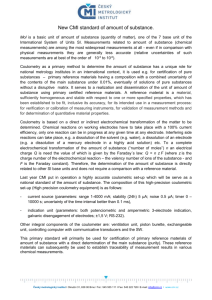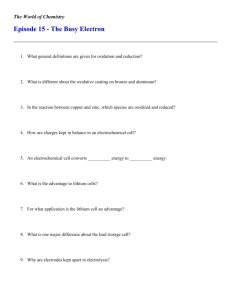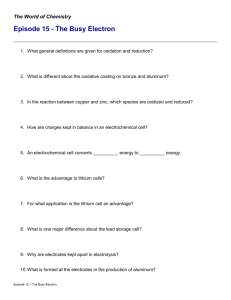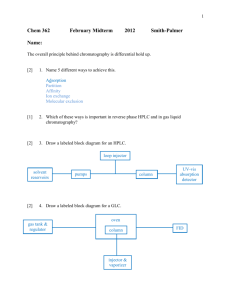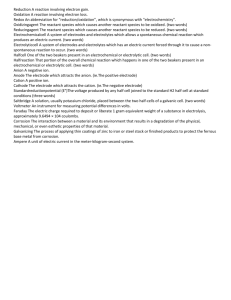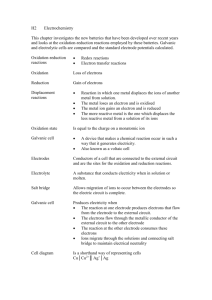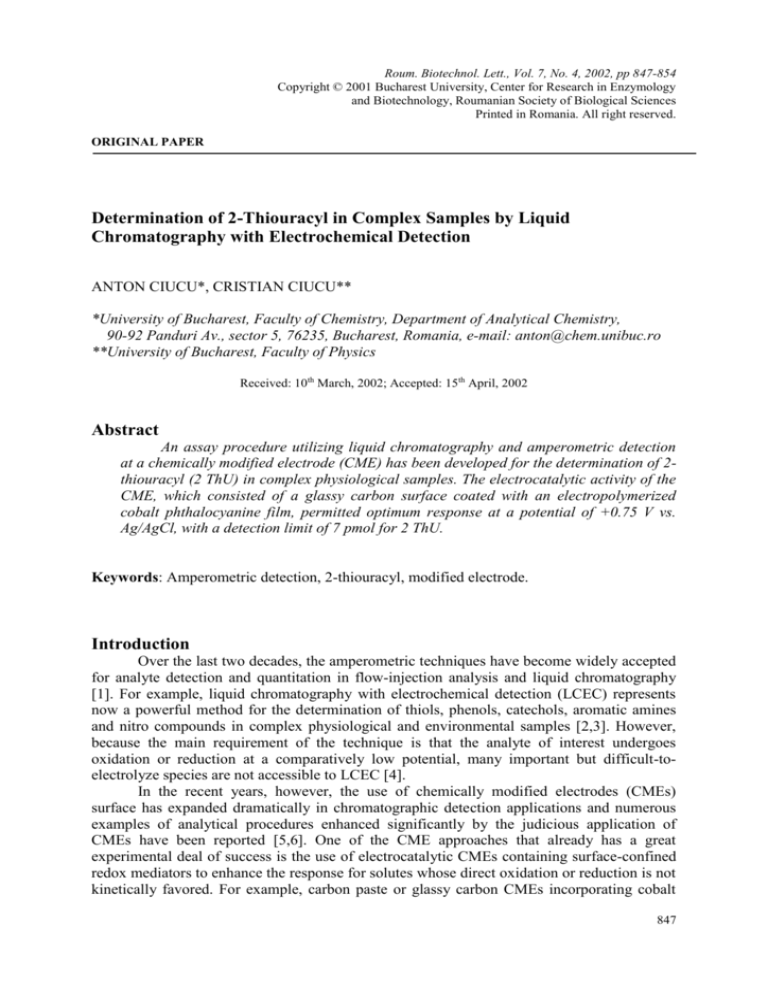
Roum. Biotechnol. Lett., Vol. 7, No. 4, 2002, pp 847-854
Copyright © 2001 Bucharest University, Center for Research in Enzymology
and Biotechnology, Roumanian Society of Biological Sciences
Printed in Romania. All right reserved.
ORIGINAL PAPER
Determination of 2-Thiouracyl in Complex Samples by Liquid
Chromatography with Electrochemical Detection
ANTON CIUCU*, CRISTIAN CIUCU**
*University of Bucharest, Faculty of Chemistry, Department of Analytical Chemistry,
90-92 Panduri Av., sector 5, 76235, Bucharest, Romania, e-mail: anton@chem.unibuc.ro
**University of Bucharest, Faculty of Physics
Received: 10th March, 2002; Accepted: 15th April, 2002
Abstract
An assay procedure utilizing liquid chromatography and amperometric detection
at a chemically modified electrode (CME) has been developed for the determination of 2thiouracyl (2 ThU) in complex physiological samples. The electrocatalytic activity of the
CME, which consisted of a glassy carbon surface coated with an electropolymerized
cobalt phthalocyanine film, permitted optimum response at a potential of +0.75 V vs.
Ag/AgCl, with a detection limit of 7 pmol for 2 ThU.
Keywords: Amperometric detection, 2-thiouracyl, modified electrode.
Introduction
Over the last two decades, the amperometric techniques have become widely accepted
for analyte detection and quantitation in flow-injection analysis and liquid chromatography
[1]. For example, liquid chromatography with electrochemical detection (LCEC) represents
now a powerful method for the determination of thiols, phenols, catechols, aromatic amines
and nitro compounds in complex physiological and environmental samples [2,3]. However,
because the main requirement of the technique is that the analyte of interest undergoes
oxidation or reduction at a comparatively low potential, many important but difficult-toelectrolyze species are not accessible to LCEC [4].
In the recent years, however, the use of chemically modified electrodes (CMEs)
surface has expanded dramatically in chromatographic detection applications and numerous
examples of analytical procedures enhanced significantly by the judicious application of
CMEs have been reported [5,6]. One of the CME approaches that already has a great
experimental deal of success is the use of electrocatalytic CMEs containing surface-confined
redox mediators to enhance the response for solutes whose direct oxidation or reduction is not
kinetically favored. For example, carbon paste or glassy carbon CMEs incorporating cobalt
847
ANTON CIUCU, CRISTIAN CIUCU
phthalocyanine as modifier have been shown to enhance the detection of thiols, hydrazine,
oxalic acid and carbohydrates [1,3].
The primary advantages cited in these reports have included greater resistance to
electrode fouling, greater control of electrode selectivity and the activation of electrode
response to new analytes that are electrolyzed either poorly or not at all at conventional
unmodified electrodes surfaces [7].
In work that is particularly relevant to the 2-thiouracyl, CMEs containing incorporated
cobalt phthalocyanine (CoPC) have been shown to carry out the electrocatalytic oxidation of
thiols at low positive potentials well suited for selective HPLC based assays [8,9]. The
electrocatalytic response of these CMEs derives from the ability of higher oxidation states of
cobalt, generated electrochemically at modest potentials, to carry out thiol oxidation
chemically under conditions comparatively free of back-ground currents and immune to most
interferences. The CMEs employed have consisted either of carbon paste electrodes
containing CoPC added manually to the paste mixture [10,11] or, more recently, glassy
carbon electrodes covered with a polymer film produced by electro-oxidation of Co
4,4',4",4"'-tetraaminophthalocyanine [1,3]. This latter approach, in particular, yielded CMEs
whose mechanical and chemical stability and broad solvent compatibility make them highly
attractive for use in HPLC applications.
2-Thiouracyl and some related thioureas are receiving growing interest as selective
melanoma (a dark pigmented malignant tumor) seekers. They are incorporated into growing
melanin, apparently due to covalent binding to dopaquinone and the adduct is gradually
tapped in the melanin polymer during its formation. To be clinically useful in melanoma
scanning, 2-thiouracyl has been radioionicated and 5-iodo-2-thiouracyl (*ITU) was found to
be localized in melanotic melanoma as selectively as thiouracil. Clinical trials with *ITU, for
the detection of malignant melanoma, are in progress and the results are, so far, promising
[12].
In further attempts to use the affinity of 2-thiouracyl for melanin-producing tissues in
the design of drugs, active against malignant melanomas, guanidine-bridged adducts of the
antraquinone drug daunorubicin with 2-thiouracyl were prepared [13].
The effect of 2-thiouracyl in correcting defects in folic acid function produced by
vitamin B12 deficiency was studied. Addition of the thyroid inhibitor, thiouracyl, to a low
methionine diet containing vitamin B12, increased the oxidation of histidine to carbon dioxide
and increased liver folate levels. It is possible that the effect of 2-thiouracyl in increasing
folate function consists both in the effect of 2-thiouracyl in decreasing levels of
methylenetetrahydrofolate reductase and also in its action in increasing S-adenosyl
methionine which exerts a feed-back inhibition of this enzyme [14].
In this paper we describe a new application involving the use of the polymer CoPC
electrodes for the determination of 2-thiouracyl (2 ThU) in complex samples. To our
knowledge, there has been no previous report concerning electrochemical detection of 2thiouracyl at either conventional or chemically modified electrodes. The assay procedure
reported here, which employs the CoPC-CME as an electrocatalytic sensing electrode for
liquid chromatography with electrochemical detection (LCED), provides an alternative
approach for the direct detection of 2-thiouracyl with no derivatization and minimum sample
treatment required. The strengths of the CME approach include its sensitivity and selectivity.
In addition, the ease and reproducibility with which fresh CME surfaces can be generated
make the approach very compatible with physiological sample matrices.
848
Roum. Biotechnol. Lett., Vol. 7, No. 4, 847-854 (2002)
Determination of 2-Thiouracyl in Complex Samples by Liquid Chromatography with Electrochemical Detection
Materials and Methods
Reagents
2-Thiouracyl and uracyl were obtained from Aldrich Co., while glutathione and Lcysteine (reduced forms) were obtained from Sigma. All chemicals were used as received,
without further purification. Co 4, 4’, 4”, 4’” tetraaminophthalocyanine was prepared
according to the procedure of Achar et al. [15]. The solutions of 2-thiouracyl were prepared in
phosphate buffer pH 3.0, ionic strength 0.05 M.
Electrodes
CMEs containing surface deposits of Co tetraaminophthalocyanine polymer
(polyCoPC) were prepared according to the method reported by Li and Guarr [16] and fully
described by Qi et al [1].
Appartus
The equipment used for cyclic voltammetry (CV), flow injection analysis (FIA) and
HPLC was essentially the same as that described previously [3]. In all cases, potentials were
measured against Ag/AgCl (3 M NaCl) reference electrode. HPLC effluents were also
monitored at a wavelength of 280 nm with a Waters Associates Model 440 Absorbance
Detector. Hydrodynamic voltammograms were obtained via FIA by recording the response of
the working electrode placed in a conventional thin-layer cell configuration. For HPLC a 150
mm long, 4.1 mm i.d. Hamilton PRP-1 column containing reversed-phase poly(styrenedivinylbenzene) packing was inserted between the injector and detector. For all flow work,
the mobile phase was 5% acetonitrile/95% 0.05 M potassium phosphate buffer adjusted to pH
3.0 with ortophosphoric acid. The flow rate was always 1.0 mL/min and the injection volume
was 20 L.
Results and Discussions
The electrochemical behavior of numerous thiol compounds at the polyCoPC-CME
has already been described elsewhere in some detail [1,3]. In general, CVs obtained for these
compounds under the mildly acidic conditions best suited for their reverse-phase
chromatography exhibited irreversible peak-shaped oxidation waves at or above +0.5 V vs.
Ag/AgCl. For 2-thiouracyl the behavior, shown in (Figure 1), was essentially the same, with
a single anodic wave with a peak potential of +0.75 V at pH 3.0. Into the cathodic direction it
observe some small reduction waves, whom intensities are a complex function of solution pH
and of electrode aging.
Figure 1. Cyclic voltammogram obtained for 0.5 mM 2 ThU in 0.050 M phosphate buffer (pH=3.0) at
polyCoPC-CME. Shown as a dashed line is the voltammogram obtain at an unmodified electrode. Scan rate, 50
mV/s.
Roum. Biotechnol. Lett., Vol. 7, No. 4, 847-854 (2002)
849
ANTON CIUCU, CRISTIAN CIUCU
At unmodified glassy carbon electrodes, no redox activity at all can be observed for 2
ThU below +1.0 V. As in our earlier work [3], the thiol currents at the polyCoPC-CME
appeared in the potential region corresponding to the Co(II)/Co(III) redox and therefore were
attributed to the catalytic oxidation of the thiol by Co(III) PC produced directly at the
electrode surface. As expected for such mediated CME processes, the observed currents were
directly proportional to the 2 ThU concentration and to the square root of the potential scan
rate employed (for scan rates up to 400 mV/s). The resulting catalytic currents (at +0.75 V)
are direct proportional to the 2 ThU concentration, in the range 0.5 - 4.0 mM (Figure 2). In
addition, the currents resulting from sulfhydryl group oxidation are controlled by diffusion,
they presenting a linear dependency of square root of the swiping velocity of the potential, for
swiping velocities up to 400 mV.
12
10
i [nA]
8
6
4
2
0
0
1
2
C
2-thiouracyl
3
4
[mM]
Figure 2. Calibration graph for 2 ThU.
CVs for 2 ThU were recorded in different solvent systems. In aqueous phosphate
buffers from pH 2.5 to 8.0, the anodic wave associated with 2 ThU oxidation occurred at
modest positive potentials at all pH values, but shifted to less positive potentials and
decreased slightly in magnitude in more basic solutions. From (Figure 3), it can be observed
that by pH decreasing (acidic media), the electrolytic process is shifting through more
positively values of the potential. CVs obtained in nonaqueous solvents containing methanol
or acetonitrile closely resembled those for purely aqueous media.
Figure 3. Influence of pH upon potential. (1) pH=2.5, (2) pH=5.5, (3) pH=8.0.
850
Roum. Biotechnol. Lett., Vol. 7, No. 4, 847-854 (2002)
Determination of 2-Thiouracyl in Complex Samples by Liquid Chromatography with Electrochemical Detection
The CME - CoPC electrode can be kept in a 2 ThU solution under stirring or cycled in
the potential range between -0.2 and 1.0 V for at least 10 hours without a considerable
decrease in the catalytic activity. During this period of time, of 10 hours, over 60
experimental determinations were done with a 1 mM 2-thiouracyl solution. It was observed a
decrease of the analytical signal of about 0.5% per hour.
On the basis of these observations, it appeared likely that LCED might be carried out
for 2 ThU at low potentials and under a wide range of solvent conditions. In particular, the
low applied potential permitted by usage of the CME should decrease the number and extent
of possible interferences, thereby simplifying the sample treatment and chromatographic
procedures required.
In (Figure 4) is presented the hydrodynamic voltammogram (HDV) for a 0.50 mM 2
ThU solution. Examination of this figure, constructed from a series of flow injection
experiments at different applied potentials, shows that 2 ThU oxidation in the flow system
was similar to that in CV, showing maximum current levels at approximately +0.75 V. As has
been seen for other reported CoPC-catalyzed oxidations [1,3,10,11], the CME activity
diminished at higher potentials and produced a peak-shaped HDV. On the basis of the HDV,
it was apparent that the optimum potential for LCED detection of 2 ThU at polyCoPC-CMEs
should fall between +0.70 and +0.80 V vs. Ag/AgCl. As all of the analytes studied here (Lcysteine, reduced glutathione, and 2 ThU) gave a good response at +0.75 V, this potential
represented a reasonable choice for most work.
Figure 4. HDV of 2 ThU at polyCoPC-CME. Mobile phase was 5% CH3CN/95% 0.050 M phosphate buffer
(pH, 3.0).
The utility of the polyCoPC-CME for LCED of thiol compounds such as L-cysteine,
glutathione, and 2 ThU is illustrated in (Figure 5), in which is presented a chromatogram
recorded at an applied potential of +0.75 V for a laboratory prepared mixture of the
compounds mentioned above. As can be seen from this figure, all three compounds present
well-formed peaks; and, of the three, only 2 ThU presents both UV and electrochemical
response.
Roum. Biotechnol. Lett., Vol. 7, No. 4, 847-854 (2002)
851
ANTON CIUCU, CRISTIAN CIUCU
For the polyCoPC-CME, peak currents at +0.75 V were linear for sample solutions
containing 2 ThU concentrations ranging from 0.3-16 mol/L (or 55-3000 g/L). This was
evidenced by least-squares analysis of data taken for five concentrations over this range (slope
of the calibration curve, 1.1 nA/M; correlation coefficient, 0.999). The limit of detection
under the above conditions was 55g/L or 7 pmol injected (signal/noise = 3).
Figure 5. Chromatogram of a mixture of: (1) 2.0 mM L-cysteine, (2) 2.0 mM glutathione, (3) 0.50 mM 2ThU
(1:1:1v/v/v): (A) electrochemical detection at a polyCoPC-CME at+0.75 V vs. Ag/AgCl and (B) u.v. detection at
280 nm.
The stability of the polyCoPC-CME response was checked by repeated injection of
samples containing added 2 ThU. The results showed that, as long as the electrode was
maintained at +0.75 V vs. Ag/AgCl, only a gradual decrease in peak current was observed.
For example, for samples doped with 2 ThU, the CME retained 90-95% of its original activity
after 5 hours of continuous chromatography and more than 20 separate injections. Operation
at a higher potential caused a much more rapid decrease in electrode response and thus should
be avoided in practice. However, the surface of the polyCoPC-CME could be rapidly and
reproducibly renewed (±5% relative standard deviation) and , at +0.75 V, required an
equilibration time of only 12-15 minutes in the flow stream. As a result, even though a single
CME surface could in principle be used for work extending over several days, our usual
practice consisted of creating and conditioning a new electrode surface at the start of each
day's work.
852
Roum. Biotechnol. Lett., Vol. 7, No. 4, 847-854 (2002)
Determination of 2-Thiouracyl in Complex Samples by Liquid Chromatography with Electrochemical Detection
Conclusion
The LCED assay described here should be highly attractive for the determination of 2
ThU in relevant physiological samples. The method is extremely sensitive, offering a
detection limit below those reported for much more complex LCUV-based assays. Most
important, the selectivity of the detection at the polyCoPC-CME is such that no derivatization
or sample treatment (other than routine particulate filtration) is required for 2 ThU
determination. In case of fouling of the electrode surface by sample constituents, the
polymeric cobalt phthalocyanine electrode surface could be renewed with a variability of less
than 10% and an equilibration time of less than 15 minutes. Furthermore, the response of the
electrodes is extremely stable, with more than 95% of the initial activity retained after 10
hours of continuous use.
References
1. X. Qi, R. P. Baldwin, H. Li, T. F. Guarr, Electroanalysis, 3, 119-125 (1991).
2. L.R. Snyder, J.J. Kirkland, Introduction to Modern Liquid Chromatography, 2nd ed.,
Wiley - Interscience, New York, pp. 153-158, 1979.
3. A. Ciucu, R.P. Baldwin, Electroanalysis, 4, 515–519 (1992).
4. P.T. Kissinger, Laboratory Techniques in Electroanalytical Chemistry, P.T. Kissinger and
W.R. Heineman Ed., Dekker, New York, pp. 191–353, 1984.
5. L.M. Santos, R.P. Baldwin, Anal.Chem., 54, 848-856 (1986).
6. R.W. Murray, "Chemically Modified Electrodes" in, Electroanalytical Chemistry, A.J.
Bard Ed., Dekker, New York, pp. 611 – 635, 1984.
7. S. Dong, Y. Wang, Electroanalysis, 1, 1989, 99-107.
8. M. K. Halbert, R. P. Baldwin, Anal. Chem., 57, 591-609, (1985).
9. M. K. Halbert, R. P. Baldwin, J. Chromatogr. Biomed. Appl., 345, 43-50, (1985).
10. R. P. Baldwin, K. N. Thomsen, Talanta, 38, l-10, (1991).
11. C. Nistor, J Emneus, L. Gorton, A. Ciucu, Anal. Chim. Acta, 387, 309-326, (1999).
12. B.S. Larsson, Melanoma Res., 1, 85-90, (1992).
13. F. Watjin, O. Bucharat, Drug Des. Deliv., 1, 131–142, (1986).
14. J.N. Keating, G. Kusano, E.L.Stokstad, Arch. Biochem. Biophys., 1, 119–124, (1988).
853
Roum. Biotechnol. Lett., Vol. 7, No. 4, 847-854 (2002)
ANTON CIUCU, CRISTIAN CIUCU
15. B. N. Achar, G. M. Fohlen, J. A. Parker, Polyhedron, 6, 1463-1470, (1987).
16. H. Li, T. F. Guarr, J. Chem. Soc. Chem. Commun., 6, 832-839, (1989).
854
Roum. Biotechnol. Lett., Vol. 7, No. 4, 847-854 (2002)

